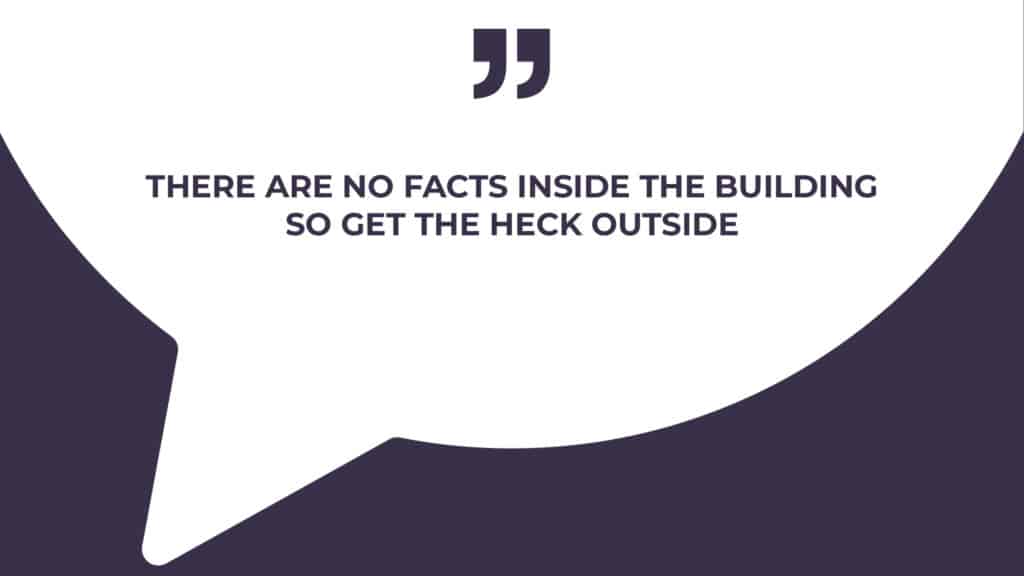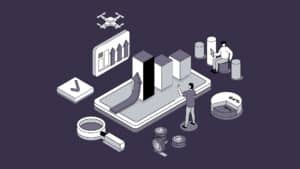How many times have you had an idea for a new business venture and, despite how inspired the idea is, the business didn’t make it in the market?
Many people begin with a brilliant idea for a startup and immediately proceed to implement their ideas by creating an app, a website, or a product, yet the business does not take off.
According to one of the most famous statistics, only 5% of innovative product ideas actually make it and succeed, but not many people talk about the reason why startups don’t succeed and what that huge percentage of failure is related to.
One of my students had a client who had an idea for a drive-through app and started to build the app without doing enough market research. As a result, the app got unnecessarily over-complicated and the development time took too long. In the meantime, a much simpler version of the idea was released in another app and took most of the market shares leading the client’s project to fail when it was finally released.
In this example, the person with the startup idea did almost everything wrong which led to the failure of his enterprise.
The fact is that 50% of the reasons why startups don’t succeed are related to the lack of data or poor research. In other words, a person with an idea for a startup might not be able to reach the right potential customers to get reliable feedback or the right data that represents the target market.
In this article, I’m focusing on those two main points, how to collect the right data and how to do reliable research as well as the different methods that startups, or anyone with an idea for that matter, can use to validate ideas.
First Rule of Startup Club!
Despite what you might be thinking, the first rule for startups is not “You do not talk about the startup”! You can talk about your startup as much as you’d like, although discretion can protect your idea from being stolen, that’s not what I’m talking about here.

In his book, The Four Steps to the Epiphany: Successful Strategies for Startups That Win, Steve Blank defined the most crucial rule for startups and people with good business ideas. In his famous quote, Blank says: “There are no facts inside the building so get the heck outside”!
What Blank means by the building here is the startup itself. Imagine that a startup is a company building. Inside that building, there are no facts, only opinions. This is why Steve Blank says that you should go outside that startup idea and take a look from the outside, from a different perspective.
To gain a different perspective or, in the words of Steve Blank, to get the heck outside, you need to discuss your new business idea with your potential customers, not your family members or friends as they can’t offer objective feedback that allows you to make the right decision.
Second Rule of Startup Club!
Don’t worry, this is still not Fight Club. You still can talk about your idea as much as you like. However, you must be careful not to fall in love with your idea. You should think it’s a great idea, you should be proud of yourself that you came up with it, and you also should be able to let it go if you find the idea to be not viable or not sustainable as a business.

Idea Validation Steps
Let’s take a detailed look at the 4 main steps to validate any idea and make an informed decision as to whether you should proceed with your idea or pivot.
- Defining Goals
- Develop a Hypothesis
- Experiment
- Analyze
1- Defining Goals

When defining goals, keep in mind that goals should always be measurable in order to be able to determine whether you reached these goals or not.
To define the goals of your idea validation, there are 4 points that you have to clear and have written in detail.
- Objectives
In the very first step, you need to determine an objective for your validation process. Find out what you are trying to validate during this process.
Are you going to validate the problem that you detected in the market, or are you validating the solution that you’re presenting for this problem?
Those are two completely different questions. With the first one, you’re going to ask the potential customers about the pain this problem is causing them, how often they face the problem, how much it represents a block in their lives, and how they currently solve this problem. When asking about a solution you’re providing for a problem, it’s more about observing the user’s behavior or experience while using that solution. Finally, you must avoid creating a solution and then looking for a problem that can be solved using that solution. Remember that the problem always has to come first.
- Problem Vs. Solution
The second question will provide the customers with information regarding your idea/product and its special features as a solution for a suggested problem and observe the feedback mainly done by taking notes for all usage steps, facial expressions, and displayed emotions like gestures or sighs. However, you should avoid asking direct questions to the customers or getting verbal opinions or suggestions from them.
The one thing to keep in mind with these goal-defining approaches is that the customer is not supposed to give you the solution.
- Understanding the Market
After you get the required information from your potential customers, you must understand the market. Are there solutions for this problem already available in the market? How are customers currently attempting to solve this problem? Is there currently a product or a service that solved this problem, even if it is primitive?
Answering all of these questions will give you an insight into the market and contribute to the success of your idea.
- Business Model
Once you have dependable answers to these questions, you need to lay down your business model. At this point, you must define how you’re going to generate revenue; B2C, B2B, B2G, ..etc, and set the other components of business activities like who are your suppliers going to be. Your business model also must include all of the essential components such as the value proposition, the company’s target market, the product’s unique feature or competitive advantage, fixed business expenses, the metrics to measure the business success, physical and intellectual resources the business will require, revenue model, and profit margin.
2- Develop a Hypothesis

In this step, you should start listing different scenarios and your potential responses to them. You can have multiple hypotheses as long as you keep each one one-dimensional. Having a complex hypothesis with many variables is wrong as it will just confuse you and make the development process harder.
- Riskiest or Critical Hypothesis
Start with the riskiest hypothesis or the most critical one. You can think of this hypothesis as the deal-breaker for your idea. If this hypothesis is not correct, your idea will not work. You can then flow with the hypotheses that have lower risk factors.
For example, while Upwork had other assumptions or hypotheses, its main or most critical assumption was that freelancers need a platform to find employers online and that employers were willing to hire freelancers they’d never met before. If there was no demand from the clients or no freelancers willing to use an online platform, the whole idea behind Upwork as a startup would not have succeeded.
- Is the Hypothesis Testable?
An important aspect of your hypothesis is that it should be testable. You must be able to test your assumption and get a clear and concise answer to the question: does it satisfy the customer? Many startups and businesses failed due to the idea not being testable. For example, when Google released Google Glass back in 2013, people were not ready for that product despite it being futuristic. The problem was that this product was ahead of its time and due to a lack of testing, Google didn’t foresee what would have been a major hit, if done at the right time, and failed miserably.
- Success Criteria with a Reasonable Threshold
This is why, like goals, each hypothesis must have success criteria for you to know whether it passed the test or not. For example, you can have in mind a percentage for the conversion rate of one feature of the product. Your test must be able to tell you whether the feature has achieved or exceeded the set conversion rate.
3- Conduct Experiments

While this is an important step that can give you clear indicators as to the success or failure of your future enterprise, most people overlook the experiment stage either due to the lack of awareness of its importance or due to the lack of knowledge of how to conduct an experiment. In this section, you’ll learn how to conduct the experiment as well as different methods to do so. This way, you’ll be able to choose the method that you prefer and suits your business premise the most!
- Proof of Concept
Proof of concept should enable you to answer the question of whether you can build the suggested solution for the problem that you have identified or not. Multiple reasons can get in the way of building the solution from needing an unavailable technology to requiring expensive resources that are not justified by the potential price. In other words, your solution can be not feasible and you should discover that in the proof of concept stage.
- Build a Prototype
Once you have proof of concept and you have confirmed the feasibility of your solution, you should start building a prototype of the solution. This stage focuses on answering the question of how you are going to build the solution. A prototype can be in the form of a UI of the app that you’re presenting as your solution.
Prototypes are not fully functioning and, in some cases, not functioning at all as their purpose is only to show an idea of the flow of the solution and what the user experience with it would be like.
- Minimum Viable Product (MVP)
Again, one of the most important questions is: Are customers willing to pay for this product?
It’s a given that you love your idea and think it’s brilliant. However, it’s important to face the truth of whether other people will love it to the extent of paying money for it. Note that the answer must contain money. So, it’s not enough that people would be willing to use your product, they must be willing to pay for it too.
Different Methods to Experiment
- Wizard of OZ
This is not the fourth step in the experimentation process, but rather a different method to conduct your experiment. In this method, you can have a static webpage or an app with a single screen that is not connected to any events and get all the functions done manually once the customer presses an image of a button, for example. The idea behind that is to get the customers to imagine how the process will go without having to build a functional product and without the customers knowing that your prototype is merely a non-functional interface.
- Concierge MVP
This is another method for experimenting with your product. Similar to the Wizard of OZ method, concierge MVP allows you to get the functions done manually with the difference that the customer might be aware that there is no app in place. The idea here is to let the customer get the final result whether the process is manual or automated. The product is going to be created once you’re sure that customers want your product/service and the process is going to be automated through that product in the future.
- Landing page
You can create a landing page describing your solution or product to potential customers with a signup form that allows them to get a trial period or a pre-order for when the product is released. This method is brilliant as it allows you to measure how large or small the demand for your product is going to be. Major brands like Apple and Samsung allow pre-orders for their new flagship releases to measure the potential demand for the phones
- Crowdfunding
This method is best with tangible products and especially hardware as the product itself has to be present for the customers to use and give feedback. So, the risk here is higher as you cannot experiment with a prototype or a dummy page as it is with software and solutions. This is why people with an idea for new hardware start a crowdfunding account to gather the necessary funds to launch and measure the need for the suggested product.
- A/B Testing
With this method, you can try two different methods of experimenting to see which one achieves a higher conversion rate or attract more customers. For example, you can set up two versions of the same landing page for your product with one element changed. One page can have a registration form with a submit button titled “Book your demo” and the other form have a button titled “Book a free consultation”.
Then you start measuring the responses that you’re getting from the first landing page vs. the second one. This way, you can compare and determine which phrasing of the two is best and get more traction.
- Interview the Customer
Talk with your customer! As simple as this idea may sound, many people miss it in the experiment phase. It’s recommended here to get honest feedback and opinions from strangers as the loving supporting feedback from your friends and family can and, in most cases, will backfire.
Obviously, you don’t have to apply all of these methods in the experiment stage. You can use several of them and you can mix and match different methods. Based on my experience, the two methods that I’ve found most effective and add a huge value are A/B testing and having in-depth face-to-face interviews with your potential customers.
Other methods can come after interviews as a way to convert qualitative insights to quantitative/numerical insights and remove subjectivity from the results and reach the best way to make the job done using numbers.
The trick to getting reliable insights and results from those methods is to be unbiased and to remain neutral especially when you’re conducting interviews with your customers in order to not affect their feedback or suggestions.
When done correctly, these methods can give you new ideas that you haven’t even thought of before.
4- Analyze Your Findings

Observe how the customer behaved and reacted to your prototype or idea during the experiment phase. Did you get new suggestions that can improve your product? PIVOT! Did you notice certain facial expressions during the feedback on certain features? Again, Pivot!
Next, you should be able to define the most important problems that the customer is facing in order to build a pattern and generalize your solution. It’s important to not resist the feedback you get from the customer no matter how hard it is for you to swallow.
Now, do you remember the success criteria that you set early in the experiment phase? It’s time to measure it!
Conclusion
Remaining neutral with your idea during the validation process is crucial for you to reach unbiased and reliable results. As stated in my second rule, DO NOT fall in love with your idea. Even when the validation goes well and you’re ready to begin your startup and launch your product, the main goal of a startup is to exit at the right time.
In other words, you’re building a successful startup to sell it to the highest bidder. This is why falling in love with your idea can get in your way of making a profit in more ways than one.
Also, remember that idea validation is an ongoing process that you have to perform with each new feature or module of the product when you need to evolve and grow your product or your market segment.
Idea validation seems like a lot of work and it can be time-consuming, yet, it is essential to guarantee that, when dropped into the market ocean, your business is going to float!




